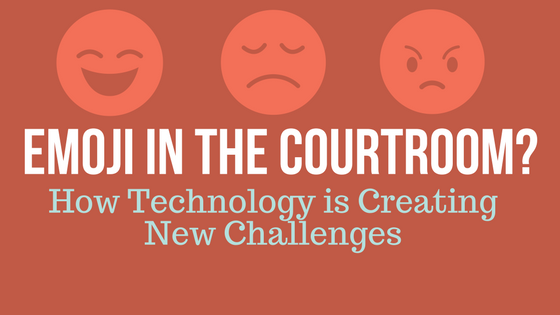According to TechCrunch, the average person spent 300 minutes per day on their smartphone in 2017. Beyond that, over 1,661 billion text messages were sent in 2016 in the US alone. With these numbers increasing, it’s no wonder that communication has changed over the years. Less face to face communication has led to an increase in text messaging and emoji use. These simple icons can inject emotion to text, convey meaning and clarify intentions. They’ve become so commonplace that Adweek reported that 60 million emoji are used on Facebook daily, and a staggering 5 billion are used in Messenger each day. In fact, Sony Pictures even made an Emoji movie last year.
I’d venture that the average person doesn’t give these symbols much thought before introducing them into a conversation. Maybe a heart face emoji to a loved one or simple smiley face to a co-worker. But what happens when emoji make their way to a court setting? Should a judge or jury decide intent based on these pictograms? That’s the question that Dr. Kirley and Dr. McMahon explore in their recent paper.
written by: Tara luther, promega
Emoji has certainly had its day in court before. In the 2011 Kinsey v. State sexual assault prosecution in Texas, the accused pointed to a “winkie face” emoji that the victim had sent to indicate consent. The court disagreed and the accused was convicted. Similarly, a court in France convicted a man for sending a text to his ex-girlfriend which included a gun emoji, deciding that it indicated a death threat in the form of an image. Again, in New Zealand, a judge sentenced a man to 8 months in jail for stalking after the man included a plane emoji in a message to his girlfriend which stated, “You’re going to f*****g get it.” The judge concluded that the plane emoji indicated the man was going to “come get” the woman.
How should courts interpret these graphics? Are they just images, or do they really convey intent? A 2015 survey of Americans showed that users feel emoji does just that. They include emoji for the following reasons: to accurately express thoughts (70.4%), to increase readers’ understanding (64.7%), to create a more personal connection with the reader (49.7%), and a ‘better fit than words for what I think’ (41.1%). In fact, MRI imaging has showed indications that people do find emotion in emoji even when the image isn’t perceived as a face (such as the use of key strokes :P.
If we can conclude that emoji does convey intention, then how do we determine the meaning behind the symbol with 100% accuracy? In 2010, a research team found that it could be misleading to interpret an emoticon as representative of a single emotion. For instance, the winking face 😉 might indicate joking, but could also signify teasing, flirting, or sarcasm. Interpretation is further hindered by a lack of emoji standardization across platforms; Apple users may see a significantly different image than their Android counterparts, if the image is even displayed at all.
Another critical component of interpreting emoji is context. Does the emoji mean something different if it’s at the end of a sentence versus in the middle? What if there are multiple emoji used? Does the succession of graphics make it easier to interpret or harder? Is the meaning changed or simply enhanced?
Even if emoji were to be interpreted correctly, do they fall under the protection of free speech? They are relatively new, and Kirley and McMahon note that (as of yet), there has been no standard response among the courts.
For all these reasons, they recommend the creation of a specialty court, similar to those providing conflict resolution in specific areas such as mental health, intellectual property, indigenous and juvenile justice law. In essence, they propose creating emoji experts from those with a background in linguistics, semiotics, machine learning, psychology, and communications. It would be up to these experts to determine when emoji use falls under free speech protection and to standardize interpretation of emoji.
How do you feel the courts should treat emoji use? We’d love to hear your comments on our Facebook, Twitter, and LinkedIn pages.
WOULD YOU LIKE TO SEE MORE ARTICLES LIKE THIS? SUBSCRIBE TO THE ISHI BLOG BELOW!
SUBSCRIBE NOW!


